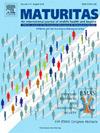慢性疼痛与更年期症状聚类之间的关系:来自英国出生队列研究的证据
IF 3.6
2区 医学
Q2 GERIATRICS & GERONTOLOGY
引用次数: 0
摘要
背景横断面研究已经证实了更年期症状和慢性疼痛之间的联系,但这种联系的方向仍然未知。我们评估了慢性疼痛是否与随后的绝经期症状相关。方法:我们使用了国家儿童发展研究的数据,这是一个1958年出生在英格兰、苏格兰和威尔士的出生队列,其中包括44岁时的生物医学扫描,评估慢性疼痛,以及50岁时的20项更年期症状问卷。慢性疼痛定义为持续时间超过3个月,慢性广泛性疼痛定义为慢性对侧上下象限疼痛和脊柱疼痛。潜在类别分析用于定义更年期症状类别(n = 4897)和结构方程模型(n = 3308),将慢性疼痛和慢性广泛性疼痛与这些类别联系起来,调整混杂变量。结果在50岁时发现了4种潜在的更年期症状。这些是低症状负担等级,一个由血管舒缩症状定义,一个由心理症状定义,一个有高症状负担。与低负担组相比,44岁时的慢性疼痛和慢性广泛性疼痛与更高症状负担类别的可能性相关。例如,慢性疼痛的高症状负担类别的优势比(95%置信区间)为2.90(2.21,3.81),慢性广泛疼痛的优势比为3.50(2.23,5.49),血管舒缩症状类别的优势比为1.50(1.16,1.94),慢性广泛疼痛的优势比为1.93(1.19,3.13)。结论早期患有慢性疼痛和慢性广泛性疼痛的妇女可能会经历更大的更年期症状负担,这在临床治疗中应予以考虑。本文章由计算机程序翻译,如有差异,请以英文原文为准。
The association between chronic pain and the clustering of menopausal symptoms: Evidence from a British birth cohort study
Background
Cross-sectional studies have demonstrated an association between menopausal symptoms and chronic pain, but the direction of the association remains unknown. We assessed whether chronic pain is associated with subsequent clusters of menopausal symptoms.
Methods
We used data from the National Child Development Study, a birth cohort of people born in 1958 in England, Scotland and Wales, which has included a biomedical sweep at age 44 when chronic pain was assessed and a 20-item menopause symptom questionnaire at age 50. Chronic pain was defined as lasting longer than 3 months, and chronic widespread pain was defined as chronic contralateral upper and lower quadrant pain and spinal pain. Latent class analysis was used to define menopause symptom classes (n = 4897) and structural equation models (n = 3308) to relate chronic pain and chronic widespread pain to these classes, adjusting for confounding variables.
Results
We found four latent classes of menopause symptom experience at 50 years. These were a low symptom burden class, one defined by vasomotor symptoms, one by psychological symptoms and one with high symptom burden. Chronic pain and chronic widespread pain at 44 years were related to greater odds of being in the higher symptom burden classes compared with the low burden group. For example, the odds ratio (95 % confidence interval) for the high symptom burden class was 2.90 (2.21, 3.81) for chronic pain and 3.50 (2.23, 5.49) for chronic widespread pain, and for the vasomotor symptom class 1.50 (1.16, 1.94) for chronic pain and 1.93 (1.19, 3.13) for chronic widespread pain.
Conclusion
Women with chronic pain and chronic widespread pain earlier in life may experience greater burden of menopausal symptoms and this should be considered in their clinical management.
求助全文
通过发布文献求助,成功后即可免费获取论文全文。
去求助
来源期刊

Maturitas
医学-妇产科学
CiteScore
9.10
自引率
2.00%
发文量
142
审稿时长
40 days
期刊介绍:
Maturitas is an international multidisciplinary peer reviewed scientific journal of midlife health and beyond publishing original research, reviews, consensus statements and guidelines, and mini-reviews. The journal provides a forum for all aspects of postreproductive health in both genders ranging from basic science to health and social care.
Topic areas include:• Aging• Alternative and Complementary medicines• Arthritis and Bone Health• Cancer• Cardiovascular Health• Cognitive and Physical Functioning• Epidemiology, health and social care• Gynecology/ Reproductive Endocrinology• Nutrition/ Obesity Diabetes/ Metabolic Syndrome• Menopause, Ovarian Aging• Mental Health• Pharmacology• Sexuality• Quality of Life
 求助内容:
求助内容: 应助结果提醒方式:
应助结果提醒方式:


